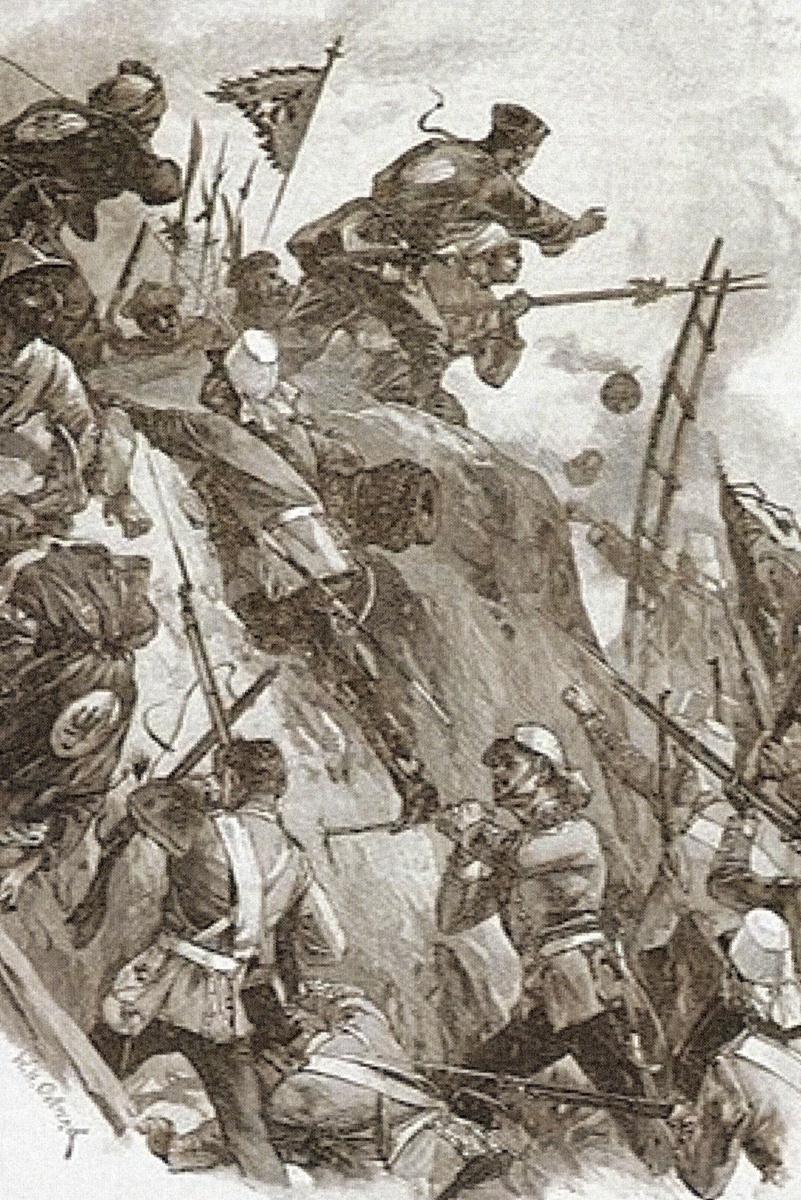Auction: 18003 - Orders, Decorations and Medals
Lot: 313
(x) Pair: Sapper J. Townend, Royal Engineers
Indian Mutiny 1857, 2 clasps, Relief of Lucknow, Lucknow (Sapper John Townend, Royal Engrs.); China 1857-60, 2 clasps, Taku Forts 1860, Pekin 1860 (Sapper John Townend. 23rd C. Royal Engrs.), contact marks and scratches to obverse, the latter with scratches around suspension claw, nearly very fine (2)
John Townend was born at Manchester in 1836, gaining civilian employment as a plumber. He attested for the Royal Engineers on 12 November 1855, and was assigned to the 23rd Company under Captain A. J. Clerke. This Company sailed for China in early 1857, reaching Singapore, but was diverted to India on hearing of the sepoy mutiny. Landing at Calcutta on 11 August 1857, it joined a force being assembled by the newly appointed Commander-in-Chief in India, Sir Colin Campbell (1792-1863).
Mutiny Service - Explosion at the Jumna Musjid
Ever since 1 July, the British garrison of Lucknow had been besieged in the city's Residency by some 12,000 rebel sepoys under Barkhat Ahmad. Generals Sir Henry Havelock and Sir James Outram, with a relief column of over 3,000 men, fought through the rebel positions and managed to reach the Residency on 25 September. Losses were so great, however, that the combined British forces were too weak to break out of the city. More rebel sepoys approached the Residency, and the siege continued.
Campbell's force marched west along the Grand Trunk Road, arriving at Cawnpore on 3 November. The second relief of Lucknow began on 14 November, when Campbell's troops secured La Martinière, a school for British and Anglo-Indian boys. The Secundra Bagh was stormed the following day, and Campbell's engineers were detailed to blow up the Moti Mahal, the last rebel position separating Campbell's force from the Residency. On 19 November, Campbell evacuated the Residency's surviving defenders and abandoned Lucknow to the sepoys.
Having consolidated his forces, Campbell made plans to recapture Lucknow in March 1858. All his engineer units were placed under the command of Lieutenant-Colonel H. D. Harness, and one of their main tasks was to defuse captured rebel ordnance, preventing any risk to Campbell's troops. On 18 March 1858, the 23rd Company received orders to neutralise a powder magazine in the Jumna Musjid, a former rebel stronghold. The Corps History of the Royal Engineers records a terrible incident:
'At the Jumna Musjid there were nine cartloads of powder found in a courtyard which Outram directed to be destroyed. As there was a well on the spot it was considered that the best method of disposing of the powder, which was in tin cases, would be to throw them down into the water. A line of men was formed [from the 23rd Company], and the cases passed from hand to hand as rapidly as possible. By some fatality one of them exploded in falling. A flame of fire flashed up, and ignited case after case all along the line till the carts were reached, when they also exploded.'
Captain Clerke and Lieutenant Brownlow, along with twenty-two sappers, lost their lives in the explosion. Townend may have been seriously injured, but was lucky to survive.
The rebel sepoys were finally driven from Lucknow on 21 March, and a furious pursuit was ordered. The 23rd Company, Royal Engineers was assigned to a Division under Brigadier-General Walpole, whose orders were to seize Fort Rooyha in Rohilkhand. Walpole's Division left Lucknow on 7 April. The British assault of 15 April was repulsed with great loss, but the sepoys abandoned the fort that night. On 17 April, 23rd Company laid charges and flattened Rooyha.
Walpole's Division pursued the rebels to Alleegunge, five miles away, inflicting nearly 600 casualties. 23rd Company then constructed a bridge across the River Ramganga, enabling the Division to affect a juncture with Sir Colin Campbell's main force at Tingree. Campbell captured Bareilly on 7 May, by which time the Indian Mutiny was almost over, but the 23rd Company fought on, destroying Fort Obmereah on 2 December and Fort Burgoodia on 27 December.
Storming the Taku Forts
In July 1860, Campbell amassed troops and supplies for a final offensive in China. The 23rd Company sailed from India to participate in the Third Battle of the Taku Forts, a decisive phase of the 2nd China War. It formed part of an 18,000-strong Anglo-French army under Lord Elgin, which landed at Peytang, ten miles north of the Peiho estuary. The four Taku Forts guarded this estuary, disrupting British and French commerce. Elgin surrounded them on 20 August, his engineers rapidly constructing batteries and earthworks. An assault was ordered the next day.
Men of the 23rd Company, under Lieutenant Pritchard, advanced with scaling ladders and were the first to gain a footing in one of the forts. After a sharp struggle and many casualties, this fort was captured. The second fort was surrounded by a moat, and 23rd Company quickly brought up pontoons to enable the troops to cross. Stunned by the speed and ferocity of the Anglo-French assault, the remaining two forts surrendered.
Having subdued the Taku Forts, Lord Elgin marched on Pekin, setting fire to the Summer Palaces. The Treaty of Tianjin was concluded on 18 October, and the 23rd Company returned to England.
In 1861 Townend transferred to the 12th Company, stationed at Grahamstown in the Cape of Good Hope. He was discharged from the Royal Engineers at Gibraltar on 17 August 1871, after 15 years and 279 days with the Colours; sold with copied discharge papers.
Subject to 5% tax on Hammer Price in addition to 20% VAT on Buyer’s Premium. For more information please view Terms and Conditions for Buyers.
Sold for
£800







